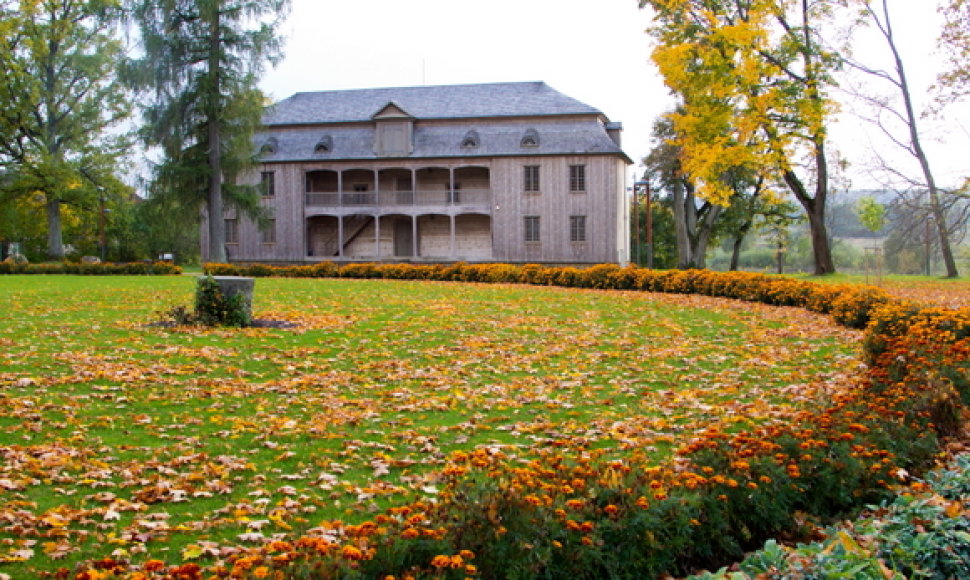The most valuable building in the estate – wooden 18-century baroque barn – houses concerts, conferences, exhibitions, ethnographic events. A barn theatre festival takes place each year in the garden outside.
For storing grain and throwing balls
“It now smells like wood, but before, one could sense the walls soaked with the smell of flour,” says director of Kurtuvėnai Regional Park Rimvydas Tamulaitis.
According to archive materials and spoken history, the barn was commissioned by the Nagurski landlords and built by serfs in 1796, using no other tools than axes.
After Lithuania regained independence, the barn was restored, but in 2001 it burned down. The two-storey wooden construction was again rebuilt in 2006, using only original technologies, materials and sticking to original architectural forms. Builders did not use a single nail. Therefore this unique example of wooden baroque architecture continues to charm with its curvy roof slopes, columns, arched beams, and semicircular roof windows.
“Landlords built the barn not only for household uses like storing flour and grain. They used to throw balls here, too,” Tamulaitis says.
The barn still houses short celebrations – it is liked by newly-weds and their guests who come down from the nearby St. Jacob the Apostle Church. “Newly-weds like to take a ride in a coach, take a photo in the park, get some privacy. We work to serve them,” he says. It costs 200 litas (58 euros) per hour to rent the barn.
Until a new multifunctional centre is built, the barn will also accommodate pupils of Kurtuvėnai Primary School – at least until winter.
Riding hall
In 2005, the town of Kurtuvėnai was struck by hurricane “Ervin.” The management of Kurtuvėnai Regional Park put together a project in 2010, seeking to rebuild structures affected by the hurricane – the stables and the coach house, also tidy up the environment and adapt the buildings to tourism.
The project was granted 2.5 million litas (724 thousand euros) from EU structural funds. Now the estate has a roofed riding hall and a riding services centre. Guests at Kurtuvėnai enjoy checking out the surrounding areas, on horses or hired bikes.
“By building the riding hall, we extended the tourist season by several months: horses support themselves in October and November now. Our regular clients do not forget us even in winter. Professional athletes train here, also amateur adventurers try out horseback riding. In addition to that, we've been working with disabled children for 15 years – we organize therapeutic horseback riding, summer camps. In winter, one can ride in sleighs,” Tamulaitis lists the range of activities for tourists.
Kurtuvėnai stables has a total of 40 horses, 23 of which have masters.
In the future, the stables should also house a visitors centre an an interactive exposition.
“Archaeological excavations unearthed about 7 thousand various finds and 5 thousand bones. The latter were discovered in a waste pit outside a former kitchen, so we can tell what noblemen used to eat since the 16th century: much poultry, wild animal meat, but far less pork than we eat today.
“According to archives, the Nagurski family owned five vessels docked in Riga port. Entries in order books show what they required to bring to the estate: bananas, oranges, tangerines, coffee, pasta, etc. We also know the kind of wines noblemen drank. An log entry from 1548 mentions a barrel to store fish,” Tamulaitis shares.
Manor bricks used for new houses
Restoration works on the Kurtuvėnai estate began in 1993. Six buildings have so far been reconstructed and adapted for tourism: officine, barn, gardener's house, stables, cowshed, and cottar-house.
Historical and archaeological surveys helped recreate an authentic structure of the estate: the park, flower gardens, terrace of the former palace, promenades, fences, a croquet field, ponds. The complex is well supplemented by the nearby Mound of Kurtuvėnai with 17-century St. Jacob the Apostle Church and old parish buildings.
The mansion itself, however, will not be rebuilt. Balustrade-surrounded terrace is the only thing marking its former site. “Archaeological excavations, before building the terrace, unearthed remains of five mansions. Nagurskis' baroque mansion was exceptionally beautiful. Originally built of larch wood, it was later rebuilt in stone by the Plater family, since larch wood made the house cold and damp,” Tamulaitis relates.
After World War One, the stone mansion was ravaged by the Bermontians (West Russian Volunteer Army). They spent two weeks drinking and partying and set the mansion on fire upon retreating. Between 1957 and 1958, local people themselves completely demolished the remains. They used bricks to build their own houses, while the rest of debris, masonry, and plastering were put into road holes and ditches. Only the stone foundations remained intact.
At the moment, restoration works are carried out in the town's market place just outside the estate. It is hoped that it will help revive the old market culture.
Several years ago, a modern three-star camping site was opened on the estate. A pub was opened in the restored cottar-house, serving visitors with traditional Lithuanian cuisine.
Plater descendants just visitors
The estate, located on an important crossroad in Samogitia, has long been ruled by powerful noble families of Lithuania.
Written sources date the first mentioning of the estate in 1498, when a local nobleman, Nicolas Jawgielowicz, gave the Church a village with 6 people.
Over the 16th century, the estate changed hands numerous times. It was ruled by the Kiezgajlo and Skaszewski families.
In the 17th century, the Kurtuvėnai estate was affected by difficult political and economic times that befell the Grand Duchy. It changed masters several times, was seriously devastated during wars with Sweden, lost almost all inhabitants after a plague. It's later masters could not match the Skaszewskis neither by their wealth nor power.
The estate prospered again only in early 18th century, when it was bought by Francis Nagurski. Three generations of the family ruled Kurtuvėnai for one century.
The Nagurski family was one of the biggest as well as most progressive landlords in the Grand Duchy of the 18th century. Its members contributed to drafting the 3 May 1791 constitution and were part of the 1794 insurrection.
However, the family could not keep the estate – Kajeton Nagurski did not produce any heirs. His relatives spent over 40 years litigating over the estate. In the end, it was given to Joana Nagurski. In the second half of the 19th century, it was bought by the Plater family.
“They modernized the estate, set up Lithuania's biggest fish farm and bred carps in their ponds. Wooden buildings were replaced by stone structures. A new mansion emerged, an officine. The Platers built a stud house, stables to keep horses that worked in two shifts – one until noon, the other one after noon. The estate had an exemplary dairy house,” Kurtuvėnai Regional Park director Tamulaitis says.
Unfortunately, Soviet deportations to Siberia in 1940 was the end of the Plater family. The estate was nationalized and administered by Bubiai Kolkhoz. Some of the buildings were left to rot, the park was seriously neglected.
“In fact, the Plater family survived, since [at the time of deportations] the mother with daughters were in Kaunas. They were warned in the train station not to return to the mansion. The women went into hiding until, using connections, they fled to Romania. Janina Smolyč, daughter of the last landlord of Kurtuvėnai, Stanislaw Plater, still lives in Warsaw. She comes to visit and is happy that the estate is restored. However, she does not make any claims to it, as she knows only too well how much it costs to maintain it,” Tamulaitis says.













